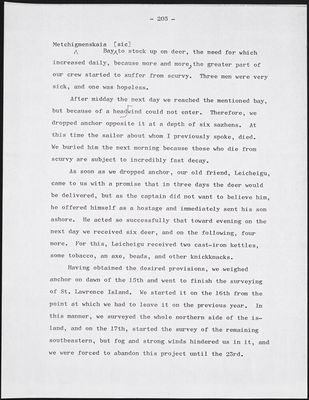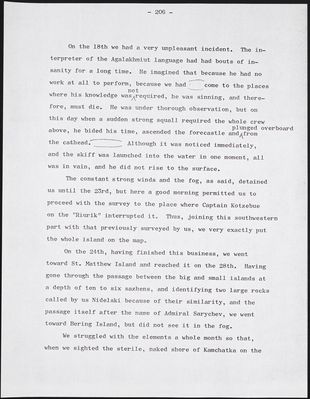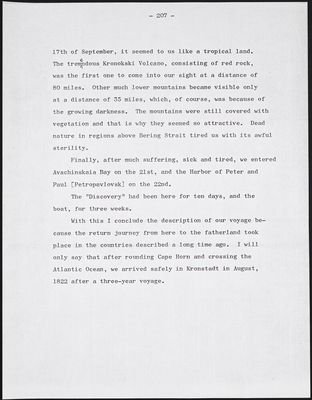Pages That Need Review
Journey of the sloop Good Intent to explore the Asiatic and American shores of Bering Strait, 1819 to 1822. Part three
mss142-vasilevShishmarev-i5-043
- 203 -
bring in fog. We scarcely had time to lift the skiff when the fog thickened so much that it was impossible to distinguish the nearest objects. With a NW wind we held toward the SW under least sail so as not to hit against the ice floating around us in the fog. This precaution served us well. In an hour after the fog descended, the boatswain shouted from the forecastle that nearby, directly in front of the bow of the vessel, was a large ice floe, but it was sighted through the fog only at the time when it was impossible to avoid hitting, because the lieutenant on watch did not have time to order a port turn, and by removing the slackened sails, at least to lessen the impact, the sloop hit the stern against the ice, and the masts started to creak in the steps. We immediately hoisted the sails in such a way that the wind would strike them from the front, and in this manner we succeeded in moving backward to move away from the ice floe and then to round it from leeward. This was not a single ice floe, but a whole part of an ice field being about a half mile long and a quarter mile wide. Having safely avoided this danger, we removed some more sails and remained in this position until the next morning. Then the fog cleared and we went under full sail in the former direction. Coming into sight of the Asiatic shore, we found ice near it as before. Sailing southward near the ice, finally at a distance of 50 miles from East Cape we were able to approach for us to start surveying it, to which we attended at once, and before 8 o'clock, reached the
mss142-vasilevShishmarev-i5-044
- 204 -
mentioned cape. Here we had to rush into the open sea because the wind started to increase by the minute, and toward midnight turned into a veritable storm with terrible gusts. We found ourselves in such a position until the ninth when it started to abate.
Toward morning of the 11th, being at the south side of the Gvozdev Islands, we sighted the "Discovery" coming out of Bering Strait. We went toward it immediately. Approaching closely, the commander of the expedition asked about the condition of our crew by way of the telegraph, and summoned our captain to him. To execute this order, we lay to and lowered a tender because the swell was still too great for small vessels. The captain and the officers who were free from watch went on the tender. Getting there, our first question was about the fate of the boat, which we did not see with the "Discovery." We learned that the boat was at Cape Newenham, seperated from the "Discovery," that this vessel, under command of Lieutenant Avinov (who is now a vice-admiral) who was given an assistant Midshipman Hall and Pilot Korgruev, was detailed to survey Bristol Bay, and afterward, in order to join the "Discovery," had instructions to attempt to be in Norton Sound by August 15, where the latter was presently directing its course.
After remaining with our comrades until evening, we went back to our sloop, and we no sooner arrived, when we lost the "Discovery" from sight. We took a course toward
mss142-vasilevShishmarev-i5-045
- 205 -
Metchigmenskaia Bay [sic] to stock up on deer, the need for which increased daily, because more and more, the greater part of our crew started to suffer from scurvy. Three men were very sick, and one was hopeless.
After midday the next day we reached the mentioned bay, but because of a headwind could not enter. Therefore, we dropped anchor opposite it at a depth of six sazhens. At this time the sailor about whom I previously spoke, died. We buried him the next morning because those who die from scurvy are subject to incredibly fast decay.
As soon as we dropped anchor, our old friend, Leicheigu, came to us with a promise that in three days the deer would be delivered, but as the captain did not want to believe him, he offered himself as a hostage and immediately sent his son ashore. He acted so successfully that toward evening on the next day we received six deer, and on the following, four more. For this, Leicheigu received two cast-iron kettles, some tobacco, an axe, beads, and other knicknacks.
Having obtained the desired provisions, we weighed anchor on dawn of the 15th and went to finish the surveying of St. Lawrence Island. We started it on the 16th from the point at which we had to leave it on the previous year. In this manner, we surveyed the whole northern side of the island, and on the 17th, started the survey of the remaining southeastern, but fog and strong winds hindered us in it, and we were forced to abandon this project until the 23rd.
mss142-vasilevShishmarev-i5-046
- 206 -
On the 18th we had a very unpleasant incident. The interpreter of the Agalakhmiut language had had bouts of insanity for a long time. He imagined that because he had no work at all to perform, because we had come to the places where his knowledge was not required, he was sinning, and therefore, must die. He was under thorough observation, but on this day when a sudden strong squall required the whole crew above, he bided his time, ascended the forecastle and plunged overboard from the cathead. Although it was noticed immediately, and the skiff was launched into the water in one moment, all was in vain, and he did not rise to the surface.
The constant strong winds and the fog, as said, detained us until the 23rd, but here a good morning permitted us to proceed with the survey to the place where Captain Kotzebue on the "Riurik" interrupted it. Thus, joining this southwestern part with that previously surveyed by us, we very exactly put the whole island on the map.
On the 24th, having finished this business, we went toward St. Matthew Island and reached it on the 28th. Having gone through the passage between the big and small islands at a depth of ten to six sazhens, and identifying two large rocks called byu us Nidelski because of their similarity, and the passage itself after the name of Admiral Sarychev, we went toward Bering Island, but did not see it in the fog.
We struggled with the elements a whole month so that, when we sighted the sterile, naked shore of Kamchatka on the
mss142-vasilevShishmarev-i5-047
- 207 -
17th of September, it seemed to us like a tropical land. The tremendous Kronokski Volcano, consisting of red rock, was the first one to come into our sight at a distance of 80 miles. Other much lower mountains became visible only at a distance of 35 miles, which, of course, was because of the growing darkness. The mountains were still covered with vegetation and that is why they seemed so attractive. Dead nature in regions above Bering Strait tired us with its awful sterility.
Finally, after much suffering, sick and tired, we entered Avachinskaia Bay on the 21st, and the Harbor of Peter and Paul (Petropavlovsk) on the 22nd.
The "Discovery" had been here for ten days, and the boat, for three weeks.
With this I conclude the description of our voyage because the return journey from here to the fatherland took place in the countries described a long time ago. I will only say that after rounding Cape Horn and crossing the Atlantic Ocean, we arrived safely in Kronstadt in August, 1822 after a three-year voyage.




